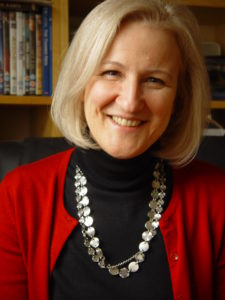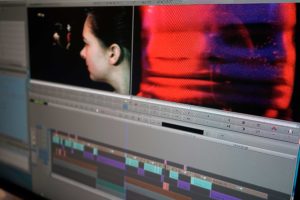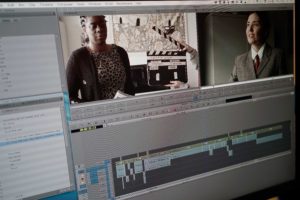Is there freedom in editing?
Stefania Marangoni has been an Editor for over 20 years, 10 years of which were spent as Senior Lecturer in Editing at The London Film School (LFS). She is passionate about the construction of film and characters, and believes that you need both freedom and restriction to truly understand the art of editing.
 In college, I studied fine art and I was doing mostly sculpture with black and white drawings. Then I became interested in moving image and video art. Installations were starting to appear as part of artworks in galleries which inspired me and caused my shift from sculpture into the visual in film. When I was at college in the ’80s there were several filmmakers that made the transition between art and filmmaking and experimentation with narrative such as Derek Jarman, Peter Greenaway and Sally Potter. I became fascinated by that.
In college, I studied fine art and I was doing mostly sculpture with black and white drawings. Then I became interested in moving image and video art. Installations were starting to appear as part of artworks in galleries which inspired me and caused my shift from sculpture into the visual in film. When I was at college in the ’80s there were several filmmakers that made the transition between art and filmmaking and experimentation with narrative such as Derek Jarman, Peter Greenaway and Sally Potter. I became fascinated by that.
This led me to contemplate the creation of characters and how to give them a journey within a narrative. I think that’s part of why I went into editing because I wanted to understand it better.
I realised very quickly that as an artist you work on your own, whereas in filmmaking you are part of a whole group of people, who all have their own ideas. I wanted to learn more about narrative and story and I recognized that editing was the key because it’s where the generated material gets shaped into the final story.
Top three skills needed as an Editor?
Arguably most important, you need to be able to tell the story.
You need to have empathy for the characters that you’re working with and to understand the emotional resonance of what they’re doing.
You also need a technical flair to work with the various software and computer editing equipment.
Is creative freedom important in video production?
As somebody who loves to have all the freedom in the world, creative freedom is important but sometimes you need to have restraint.
Some directors give themselves restrictions in order to form the narrative in a certain way, like Lars von Trier. He restricts himself on artificial lighting, special effects or technology to take back power as an artist as opposed to the studio, in a movement known as Dogme 95. On one hand you want to be able to have the freedom to create something beautiful and do what you want but by focusing on just one aspect, you are already narrowing down the elements.
You have to strike a balance between what you, or the whole production team, wants to achieve alongside giving yourself the mental freedom to think outside of the box.
At LFS, we would deliberately give students specific restraints because we wanted them to learn to tell stories without the bells and whistles. We wanted them to learn what shots are important in the story and get to the core of the narrative.
There is creativity and freedom as an editor but it depends on the project you’re working on and how you’re collaborating with people. If the senior production team gets a sense that you understand what they’re trying to achieve, they’re confident to let you experiment. Sometimes this can be really influential, as the director’s final product can find new means of expression because of your input.
One of Stefania’s on-screen edits
What aspects of editing will develop in 2017?
We can now shoot a film with a phone and young people are learning to use the language of editing at an early age. They’re so used to using computers that they don’t have the barriers that existed several years ago and there are lots of digital programs that are available to use for editing. Having this software readily available allows the development of both the technical and collaborative skills; both of which are crucial for aspiring editors.
These days, people can use pared-down versions of professional software (Premiere, Avid) on their mobile devices which is a trend that I think will develop this year.
What aspects of filmmaking were you limited on when you were growing up?
I was restricted by costs – 30 years ago I was using U-matic tapes at art school, now students have access to 4K technology at relatively reasonable costs.
Film was more common but it was always an expensive medium. The cameras were expensive and then you had the cost of processing. Nowadays, though you still need to have the right skills to create something of quality and there is more access to equipment and training. 
Another of Stefania’s on-screen edits
If money was no object, what would your editing suite look like?
Have you seen Minority Report with Tom Cruise? The virtual reality interface where he can move anything to where he wants – that’s what my ideal editing suite looks like. Who knows what will happen in the future; VR technology is coming on very quickly so perhaps I’ll have my technology sooner than I think!
It’s all about the interface for the end user though. The digital architecture behind is still very complex. But it’s all about focusing more on the freedom of storytelling.
With the technology and filmmaking world developing at a rapid rate, I think editing still remains a wonderful medium for expression and allows creative freedom to flow and collaborations to continue.

